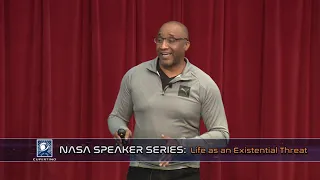17 Jun 2020
NASA has landed in Cupertino for a year-long speaker series aimed at educating, motivating, and entertaining the community. The third event in the series was recorded June 17, 2020 at the Cupertino Community Hall.
The development of the 2011 Mars Science Laboratory (MSL) heatshield underwent many difficulties and twists, as the entry vehicle was designed to be the largest ever sent to Mars. During testing, the heatshield material melted, flowed, and ultimately disappeared unexpectedly. This failure prompted a wholesale redesign and assembly of the heatshield, all accomplished in a short period of time. Dr. Hwang, a project manager in the Entry Systems Technology Division, will detail the trials and tribulations of the experience and will also preview the next Mars mission, which uses the same re-designed heatshield material developed for MSL.
The development of the 2011 Mars Science Laboratory (MSL) heatshield underwent many difficulties and twists, as the entry vehicle was designed to be the largest ever sent to Mars. During testing, the heatshield material melted, flowed, and ultimately disappeared unexpectedly. This failure prompted a wholesale redesign and assembly of the heatshield, all accomplished in a short period of time. Dr. Hwang, a project manager in the Entry Systems Technology Division, will detail the trials and tribulations of the experience and will also preview the next Mars mission, which uses the same re-designed heatshield material developed for MSL.
- 3 participants
- 58 minutes

19 Feb 2020
NASA has landed in Cupertino for a year-long speaker series aimed at educating, motivating, and entertaining the community. The second event in the series was recorded February 19, 2020 at the Cupertino Community Hall.
The state of the art for entry spacecraft, such as the Apollo capsule, utilizes Reaction Control System (RCS) thrusters for steering. These thrusters are typically mounted on the backshells of the spacecraft to maneuver them during atmospheric entry. Deployable Entry Vehicles (DEVs), a new class of entry spacecraft, have no backshell. Thus, mounting RCS thrusters is a non-trivial challenge.
Dr. Wendy A. Okolo, an aerospace research engineer at NASA Ames Research Center, presents her efforts on the “Pterodactyl” project to develop the control techniques that will make maneuvering and precision landing of DEVs a reality.
The state of the art for entry spacecraft, such as the Apollo capsule, utilizes Reaction Control System (RCS) thrusters for steering. These thrusters are typically mounted on the backshells of the spacecraft to maneuver them during atmospheric entry. Deployable Entry Vehicles (DEVs), a new class of entry spacecraft, have no backshell. Thus, mounting RCS thrusters is a non-trivial challenge.
Dr. Wendy A. Okolo, an aerospace research engineer at NASA Ames Research Center, presents her efforts on the “Pterodactyl” project to develop the control techniques that will make maneuvering and precision landing of DEVs a reality.
- 9 participants
- 1:13 hours

22 Jan 2020
NASA has landed in Cupertino for a year-long speaker series aimed at educating, motivating, and entertaining the community. The first event in the series was recorded January 22, 2020 at the Cupertino Community Hall.
The first speaker, Jerry Davis, is a former Global NASA Chief Information Security Officer, whose talk is titled "Life as an Existential Threat." He discusses how he overcame the existential threat of life—including extreme poverty, hunger, homelessness, and racism—to become one of the most inspirational security executives today.
The first speaker, Jerry Davis, is a former Global NASA Chief Information Security Officer, whose talk is titled "Life as an Existential Threat." He discusses how he overcame the existential threat of life—including extreme poverty, hunger, homelessness, and racism—to become one of the most inspirational security executives today.
- 13 participants
- 1:33 hours

